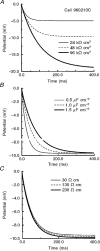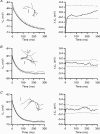Passive electrotonic properties of rat hippocampal CA3 interneurones
- PMID: 10066901
- PMCID: PMC2269181
- DOI: 10.1111/j.1469-7793.1999.743ab.x
Passive electrotonic properties of rat hippocampal CA3 interneurones
Abstract
1. The linear membrane responses of CA3 interneurones were determined with the use of whole-cell patch recording methods. The mean input resistance (RN) for all cells in this study was 526 +/- 16 MOmega and the slowest membrane time constant (tau0) was 73 +/- 3 ms. 2. The three-dimensional morphology of 63 biocytin-labelled neurones was used to construct compartmental models. Specific membrane resistivity (Rm) and specific membrane capacitance (Cm) were estimated by fitting the linear membrane response. Acceptable fits were obtained for 24 CA3 interneurones. The mean Rm was 61.9 +/- 34.2 Omega cm2 and the mean Cm was 0.9 +/- 0.3 microF cm-2. Intracellular resistance (Ri) could not be resolved in this study. 3. Examination of voltage attenuation revealed a significantly low synaptic efficiency from most dendritic synaptic input locations to the soma. 4. Simulations of excitatory postsynaptic potentials (EPSPs) were analysed at both the site of synaptic input and at the soma. There was little variability in the depolarization at the soma from synaptic inputs placed at different locations along the dendritic tree. The EPSP amplitude at the site of synaptic input was progressively larger with distance from the soma, consistent with a progressive increase in input impedance. 5. The 'iso-efficiency' of spatially different synaptic inputs arose from two opposing factors: an increase in EPSP amplitude at the synapse with distance from the soma was opposed by a nearly equivalent increase in voltage attenuation. These simulations suggest that, in these particular neurones, the amplitude of EPSPs measured at the soma will not be significantly affected by the location of synaptic inputs.
Figures







Similar articles
-
Passive normalization of synaptic integration influenced by dendritic architecture.J Neurophysiol. 1999 Dec;82(6):3268-85. doi: 10.1152/jn.1999.82.6.3268. J Neurophysiol. 1999. PMID: 10601459
-
Factors determining the efficacy of distal excitatory synapses in rat hippocampal CA1 pyramidal neurones.J Physiol. 1998 Mar 1;507 ( Pt 2)(Pt 2):441-62. doi: 10.1111/j.1469-7793.1998.441bt.x. J Physiol. 1998. PMID: 9518704 Free PMC article.
-
Effect, number and location of synapses made by single pyramidal cells onto aspiny interneurones of cat visual cortex.J Physiol. 1997 May 1;500 ( Pt 3)(Pt 3):689-713. doi: 10.1113/jphysiol.1997.sp022053. J Physiol. 1997. PMID: 9161986 Free PMC article.
-
Physiology and anatomy of synaptic connections between thick tufted pyramidal neurones in the developing rat neocortex.J Physiol. 1997 Apr 15;500 ( Pt 2)(Pt 2):409-40. doi: 10.1113/jphysiol.1997.sp022031. J Physiol. 1997. PMID: 9147328 Free PMC article.
-
Electrotonic profiles of interneurons in stratum pyramidale of the CA1 region of rat hippocampus.J Neurophysiol. 1994 May;71(5):1948-58. doi: 10.1152/jn.1994.71.5.1948. J Neurophysiol. 1994. PMID: 8064358
Cited by
-
Quantitative investigations of axonal and dendritic arbors: development, structure, function, and pathology.Neuroscientist. 2015 Jun;21(3):241-54. doi: 10.1177/1073858414540216. Epub 2014 Jun 27. Neuroscientist. 2015. PMID: 24972604 Free PMC article. Review.
-
Quantitative arbor analytics: unsupervised harmonic co-clustering of populations of brain cell arbors based on L-measure.Neuroinformatics. 2015 Jan;13(1):47-63. doi: 10.1007/s12021-014-9237-2. Neuroinformatics. 2015. PMID: 25086878
-
Anatomical and electrophysiological comparison of CA1 pyramidal neurons of the rat and mouse.J Neurophysiol. 2009 Oct;102(4):2288-302. doi: 10.1152/jn.00082.2009. Epub 2009 Aug 12. J Neurophysiol. 2009. PMID: 19675296 Free PMC article.
-
Using a Semi-Automated Strategy to Develop Multi-Compartment Models That Predict Biophysical Properties of Interneuron-Specific 3 (IS3) Cells in Hippocampus.eNeuro. 2016 Sep 19;3(4):ENEURO.0087-16.2016. doi: 10.1523/ENEURO.0087-16.2016. eCollection 2016 Jul-Aug. eNeuro. 2016. PMID: 27679813 Free PMC article.
-
Evolving Simple Models of Diverse Intrinsic Dynamics in Hippocampal Neuron Types.Front Neuroinform. 2018 Mar 13;12:8. doi: 10.3389/fninf.2018.00008. eCollection 2018. Front Neuroinform. 2018. PMID: 29593519 Free PMC article.
References
-
- Bernander O, Koch C, Douglas RJ. Amplification and linearization of distal synaptic inputs to pyramidal cells. Journal of Neurophysiology. 1994;72:2743–2753. - PubMed
-
- Carnevale NT, Johnston D. Electrophysiological characterization of remote chemical synapses. Journal of Neurophysiology. 1982;407:606–621. - PubMed
-
- Carnevale NT, Tsai KY, Claiborne BJ, Brown TH. Comparative electrotonic analysis of three classes of rat hippocampal neurons. Journal of Neurophysiology. 1997;78:703–720. - PubMed
Publication types
MeSH terms
Substances
LinkOut - more resources
Full Text Sources
Miscellaneous

